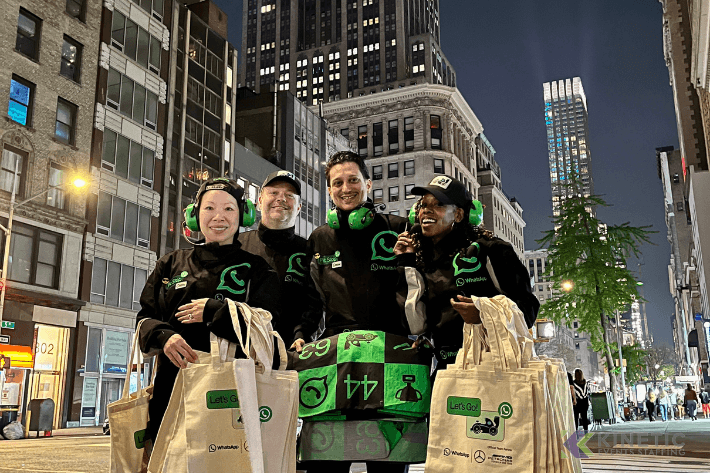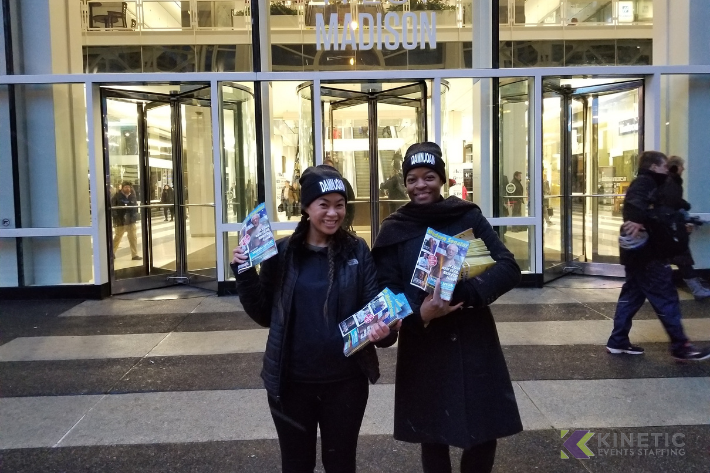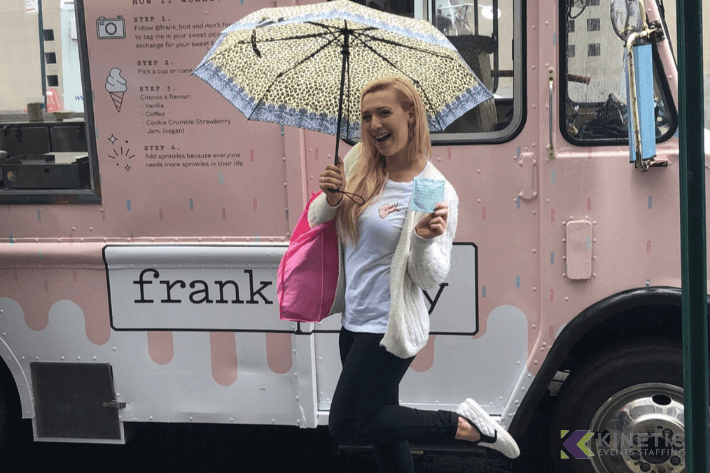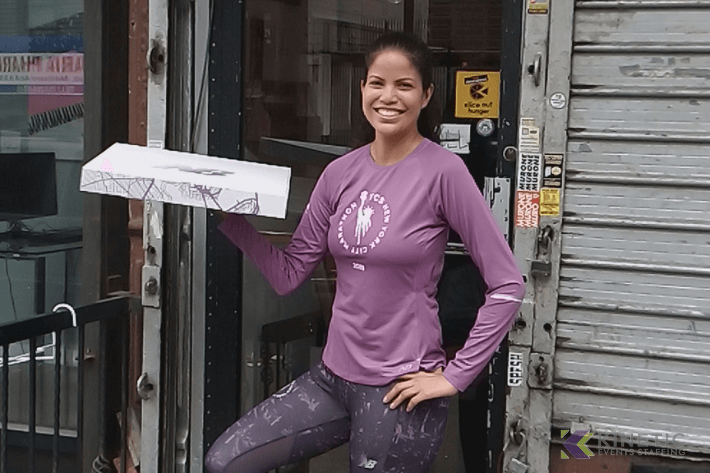In the concrete jungle where marketing messages bombard consumers from every angle, street team marketing offers something increasingly rare: authentic human connection. New York City, with its dense population and pedestrian culture, provides fertile ground for street teams to create meaningful brand interactions. But success in this space requires more than just putting people on corners with flyers.
The Consumer Perspective: Why New Yorkers Stop (Or Don't)
When was the last time you stopped to engage with a street team? If you're like most New Yorkers, you've probably developed what locals call "street blinders" – that ability to walk past dozens of marketing attempts without breaking stride.
As a potential client considering street team marketing, this reality check is crucial. New Yorkers are sophisticated consumers who can spot inauthentic marketing from blocks away. They're not stopping for just anyone with a branded t-shirt and a stack of flyers.
"The average New Yorker encounters over 5,000 advertising messages daily," explains marketing strategist Maria Gonzalez from Journal of Experiential Marketing. "To break through, street teams must offer genuine value in that moment – whether it's solving an immediate problem, providing entertainment, or offering something truly unique."
Successful street team engagements typically share these characteristics:
- They're contextually relevant to the location and moment
- They offer clear, immediate value (not just a sales pitch)
- They respect the consumer's time and space
- They create a memorable, shareable experience
Consider the difference between two approaches: Team A stands on a corner handing out generic flyers to everyone passing by, achieving a 0.5% engagement rate. Team B sets up near Bryant Park during lunch hour with branded umbrellas during an unexpected summer shower, achieving a 22% engagement rate and generating social media buzz. Same budget, dramatically different results.
Location, Timing, and Density: The Strategic Trifecta
In street team marketing, the old real estate adage applies: location, location, location. But in NYC, timing and population density create a complex equation that requires strategic planning.
High-Density Areas Worth Considering:
- Midtown/Times Square: Highest tourist density, but lowest local engagement
- Financial District: High professional density during business hours, dead after 6pm
- Union Square/Flatiron: Strong mix of professionals, students, and shoppers
- Williamsburg/DUMBO: Younger demographic, receptive to innovative brands
- Upper East/West Side: Affluent demographic, higher engagement with premium offerings
The timing of your campaign is equally crucial. Lunch hours (12-2pm) typically offer the highest engagement potential in business districts, while weekend afternoons work better in shopping and entertainment areas. Seasonal considerations also matter – summer sees more tourists but fewer locals, while fall and spring offer the best overall mix.
"Population density isn't just about raw numbers," notes field marketing director James Chen from a 2025 Marketing Dive article. "It's about the right density of your specific target audience when they're in a receptive mindset."
For example, a financial services brand targeting young professionals might find better engagement with a smaller but more targeted audience outside WeWork locations at 8:30am than with the massive but unfocused crowds at Times Square at noon.


Navigating NYC Permitting Laws: Stay Legal, Stay Effective
Nothing kills a street team campaign faster than being shut down by authorities. New York City has specific regulations governing street marketing activities, and ignorance of these rules can result in fines and wasted marketing dollars.
The Street Activity Permit Office (SAPO) oversees most street marketing activities. Depending on your specific activities, you may need:
- Street Activity Permit: Required for most marketing activities that use public space
- Sampling Permit: Specifically for distributing food or beverage samples
- Sound Device Permit: Required if using amplified sound
- Special Event Permit: For larger activations that may impact traffic
Application processes vary, but generally require submission 10-30 days before your event. Costs range from $25 for basic permits to several thousand dollars for complex events.
Areas with special restrictions include:
- Times Square Alliance District (special permissions required)
- Business Improvement Districts (require additional approvals)
- Parks and public plazas (separate permitting process)
- Subway stations and platforms (MTA jurisdiction)
"Many brands make the mistake of assuming a small footprint means they don't need permits," warns compliance specialist David Rodriguez from Navigating Promotional Regulations in Major US Cities. "Even a single person handing out flyers technically requires proper permitting in most NYC locations."
Working with experienced street team agencies familiar with NYC regulations can help navigate this complex landscape and prevent costly shutdowns.
Logistics: Getting Supplies to Your Team in the Urban Jungle
Consider these logistical realities:
- Transportation: Most team members will arrive via public transit, limiting what they can personally carry
- Storage: Few activation sites have nearby storage options
- Weather: NYC's unpredictable weather can damage materials and affect team mobility
- Restocking: Once deployed, teams can't easily return for additional supplies
Successful NYC street team campaigns typically employ these logistical strategies:
- Hub and Spoke Model: Establish a central storage location (the hub) where teams can collect materials before deploying to various locations (the spokes). Hotels, co-working spaces, or temporary storage units can serve as effective hubs.
- Supply Calculation: For giveaway items, the formula (Hours × Expected Hourly Engagement × 1.2) provides a reliable estimate with a 20% buffer. For a 4-hour activation expecting 50 engagements per hour, prepare approximately 240 items.
- Team Captains: Designate one team member as the logistics captain responsible for inventory management and communication with headquarters.
- Digital Assets: Where possible, supplement physical materials with digital alternatives (QR codes, digital coupons) to reduce logistical burden.
- Local Partnerships: Establish relationships with businesses near activation sites that might allow temporary storage or serve as emergency supply points
"We once had a client who shipped 10,000 promotional items directly to Times Square for a street team activation, only to discover there was nowhere to receive or store them," recalls event coordinator Sarah Johnson. "The entire campaign had to be postponed while we scrambled for solutions. Proper logistical planning would have prevented this entirely."


Beyond the Basics: Elevating Your NYC Street Team Campaign
While location, timing, permits, and logistics form the foundation, truly successful NYC street team campaigns incorporate these additional elements:
Team Training for NYC-Specific Interactions
New Yorkers interact differently than consumers in other markets. Train your team to:
- Respect personal space (the "NYC bubble")
- Make their pitch in 10 seconds or less
- Read body language for engagement potential
- Handle rejection professionally
- Answer neighborhood-specific questions
Integrated Digital Components
The most effective street teams don't just create in-person impressions; they drive digital engagement:
- Photo opportunities designed for social sharing
- Geotargeted social ads that complement street team locations
- QR codes linking to location-specific digital experiences
- Data collection mechanisms that comply with privacy regulations
Measurement Beyond Impressions
Sophisticated street team campaigns establish clear KPIs:
- Conversion tracking through unique promo codes
- Foot traffic increases to nearby retail locations
- Social media mention tracking with campaign-specific hashtags
- Follow-up surveys to measure brand recall and sentiment
Conclusion: The Human Touch in a Digital World
In a marketing landscape increasingly dominated by digital channels, street teams offer something algorithms can't replicate: authentic human connection. When executed with strategic planning, proper permitting, and logistical precision, street team marketing can cut through the noise of New York City and create meaningful brand experiences.
The most successful campaigns understand that street team marketing isn't just about distribution – it's about creating moments that matter in the daily lives of New Yorkers. By putting yourself in the consumer's shoes, selecting high-density locations at optimal times, navigating permitting requirements, and solving logistical challenges, your brand can transform the streets of New York into powerful marketing channels that generate both immediate engagement and lasting brand affinity.
Whether you're promoting a product launch, driving app downloads, or building awareness for a new service, street teams remain one of the most effective ways to bring your brand to life in the city that never sleeps
